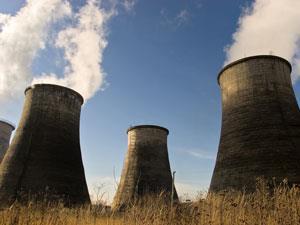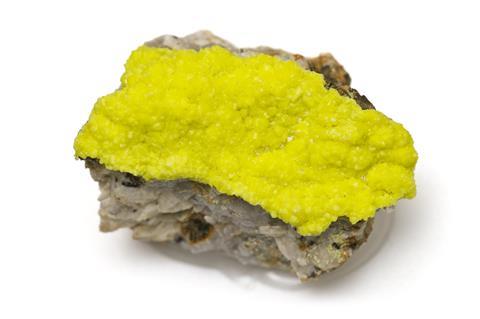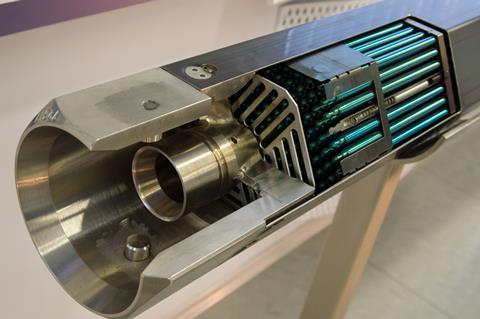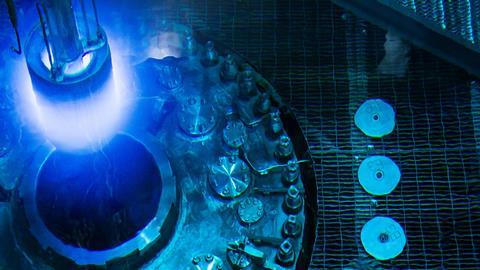Meera Senthilingam
This week we learn what it takes to fuel a nuclear reactor with Phillip Broadwith.
Phillip Broadwith
Imagine trying to separate two isotopes of an element that are chemically identical apart from the fact that the useful ones that you actually want are just a tiny bit lighter than the others - and they make up less than 1% of the total number of atoms. That is the problem facing anyone trying to make fuel for a nuclear reactor - or a nuclear bomb.
Uranium-235 is the isotope required for the fission process that provides the energy for both nuclear bombs and power stations. Unfortunately, over 99% of natural uranium is the slightly heavier isotope uranium-238. Most power plants need fuel enriched to contain at least 3 or 4% uranium-235, and weapons-grade uranium contains 90% or more of uranium-235.

So how can we increase the proportion of uranium-235, when the only difference between it and its less fissile cousin is three neutrons-worth of mass out of 230-odd in the whole atom? The answer is: with great difficulty! And this technical hurdle has helped to slow down the proliferation of nuclear weapons, but also keeps the cost of producing nuclear fuels a little higher.
But how do they do it? It all comes down to momentum. When you give a mixture of particles some energy - be they atoms, molecules or whatever - the heavier ones move slightly slower than the lighter ones. This is most pronounced for gases, so what we really need is a gaseous form of uranium.
But the boiling point of uranium metal is over 4000?C, which makes it rather impractical to work directly with uranium gas! Enter uranium hexafluoride; it's a much more practical alternative that is a crystalline solid at room temperature, and sublimes directly to a gas at around 57?C - a much easier temperature to reach than 4000?C. And at a slightly higher pressure it can be liquefied, which makes it easy to transfer between different pieces of equipment.
But perhaps the biggest advantage of UF6, apart from its ideal physical properties, is the fact that fluorine only has one naturally occurring isotope. All atoms of fluorine have the same mass, which means that the only difference in mass between UF6 containing uranium-235 and UF6 containing uranium-238 is the mass of the uranium atom.
But uranium hexafluoride is not a particularly pleasant compound. To make it, you either have to react uranium metal with elemental fluorine, or take purified uranium ore, dissolve it in nitric acid, treat it with ammonia and then reduce it with hydrogen to make uranium dioxide. Reacting that with hydrofluoric acid makes UF4, and finally oxidising with fluorine gas makes UF6. Neither of those are processes I'd be too keen to try in a hurry!

UF6 itself is corrosive to most metals. But with some, like iron and nickel, it reacts with the surface to form a protective layer of the metal fluoride, which is why it can be stored in steel cylinders. It also needs to be kept really dry. The slightest whiff of water and it breaks down into uranyl difluoride (UO2F2) and hydrofluoric acid. HF is extremely corrosive and it will attack glass and steel alike; it is also very toxic and will burn skin and dissolve bone.
Even with uranium hexafluoride, the task of separating the two isotopes is technologically challenging. The UF6 is fed into massive gas centrifuges, which accelerate the gas molecules to over 100,000 revolutions per minute to separate them - the heavier ones move towards the outside wall of the centrifuge, whereas lighter ones stay nearer the middle. Heating the bottom of the centrifuge and cooling the top also sets up convection currents that carry lighter molecules to the top while heavier ones settle to the bottom and can be continuously removed.
Because the difference in mass between the two molecules is so small, it takes many passes through the centrifuge to even produce reactor-grade low-enriched uranium. In uranium enrichment facilities, there are therefore usually hundreds or even thousands of centrifuges set up to feed from one to the next in cascades. This means building a uranium enrichment plant is not something that can easily be done inconspicuously - a fact that helps the international community keep tabs on who is enriching uranium and judge whether it's likely that they're making fuel- or weapons-grade material. That helps police the international treaty on non-proliferation of nuclear weapons.
However, there are possible alternatives that could make uranium enrichment simpler and cheaper. One option is Separation of Isotopes by Laser Excitation, or Silex, developed by scientists in Australia. Silex uses a laser at just the right frequency to selectively excite and ionise only the UF6 molecules containing uranium-235. The charged molecules are then much easier to separate from the neutral ones containing uranium-238 using an electromagnetic field. General Electric and Hitachi are aiming to build a demonstration plant for the technology, but there are concerns that the simplicity of the laser technology compared to centrifuges could make it easier for rogue states or factions to produce weapons-grade uranium.

But whether you use a laser or a centrifuge, and whether you're trying to help solve the world's energy crisis or destroy it in a nuclear war, you're going to need some very brave and experienced (or very reckless) chemists to deal with the compound that makes it all possible in the first place.
Meera Senthilingam
Do you have what it takes? Not sure if I do either! Chemistry World's Phillip Broadwith there, with the nuclear chemistry of uranium hexafluoride. Next week we move from compounds fuelling our future to a compound helping us venture into the unknown
Brian Clegg
Anyone with a serious interest in space exploration will know about the debates over the scientific value of manned spaceflight. Many would argue that it is very hard to justify this as an effective use of scarce finances - unmanned probes are just as capable, easier to achieve and less expensive. America did not put a man on the Moon for science, it was a political action. But there is always one fallback for those who support the expense and risk of manned missions - that the challenges of getting human beings into space drives the development of exciting new technology. Technology that then finds everyday terrestrial applications. And one of the most commonly cited examples of the space race's philanthropy is polytetrafluorethylene, or PTFE, which Nasa used extensively in the shuttles and suits that carried its astronauts into space.
Except that, in this case, the argument is founded on a myth. Polytetrafluorethylene certainly had its uses in space, but this polymer was around long before Nasa was even formed.
Meera Senthilingam
And to unravel this history of PTFE join Brian Clegg in next week's Chemistry in its element. Until then, thank you for listening, I'm Meera Senthilingam.
(Promo)
Chemistry in its element comes to you from Chemistry World, the magazine of the Royal Society of Chemistry and is produced by thenakedscientists dot com. There are more compounds that count on our website at chemistryworld dot org slash compounds.
(End promo)













No comments yet